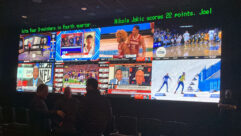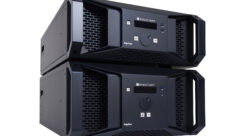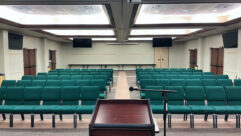

Make Way for Digital
Finally, it is over. As I write this, the never-ending spring trade show season has ended, officially capped off by InfoComm 2008 in broiling-hot Las Vegas. This year’s show, which was combined with the NSCA Expo for the first time, saw almost a 10 percent increase in attendance and took up the North and Central Halls of the Las Vegas Convention Center.
Finally, it is over. As I write this, the never-ending spring trade show season has ended, officially capped off by InfoComm 2008 in broiling-hot Las Vegas. (How does 106 degrees during the day and 102 degrees at night sound to you?). This year’s show, which was combined with the NSCA Expo for the first time, saw almost a 10 percent increase in attendance and took up the North and Central Halls of the Las Vegas Convention Center.
Pete Putman, CTS, ISF
While the attendance numbers were impressive, what was more impressive was the emphasis on digital infrastructure and displays. Historically, the pro AV space has lagged in adopting digital technology, and no further proof was required than to walk the aisles of the NAB show each April.
At past NAB shows, I’d see widescreen, HD-resolution displays, IT backbones with fiber optics and Cat-5 signal distribution, SDI and HD-SDI interfaces, and MPEG encoders and decoders. In contrast, at InfoComm, there were still plenty of 4:3 aspect ratio projectors, analog RGBHV interfaces, RS-232 controllers, and analog audio interfaces, not to mention Composite and S-Video products and 800×600 (SVGA) displays.
That all changed this year, as NAB regulars like Harris, Thomson-Grass Valley, and Tandberg shared space with the likes of Extron, Crestron, Epson, and InFocus. To be sure, many of these digital infrastructure companies were in Las Vegas chasing digital signage business, such as content management and distribution. But others were showing fiber-optic interfaces, video servers, proprietary network management software, and embedded controllers for tiled displays. More importantly, they were using 16:9 and 16:10 displays to demonstrate these products—another indicator that we’re ready to pull that last foot out of the 20th century.
Due to teaching commitments for InfoComm’s Professional Education and Training Committee (PETC), I didn’t have as much time to spend on the show floor. But I still managed to visit several manufacturers and found some cool new products. In no particular order, here they are.
Sanyo: Have you heard of 4LCD imaging technology? Sanyo had it on display this year in its new PLC-XP200L ($9,995), an LCD projector rated at 7,000 lumens. It uses a conventional 3LCD imaging engine with a fourth panel added to control yellow spectral response, a difference that could be seen clearly in a side-by-side demo with a comparable 3LCD Sanyo model.
Sharp: Folks have long complained that 3-chip DLP technology is just too expensive in desktop and installation projectors. Not any more. Sharp’s XG-P560W is priced at $17,000 and uses three WXGA (1280×800) DMDs to develop 5,200 lumens. There’s also a 3-chip XGA version, the XG-P610X, which will sell for $14,995.
projectiondesign: Leave it to those clever folks in Fredrikstad, Norway, to come up with the smallest 3D projector ever. Its lightweight F10 AS3D (no price given) uses a single XGA+ (1400×1050) DMD, runs at 120 Hz for active shutter stereo glasses, and is compatible with both IR transmitted and White Light (DLP Link) LCD 3D shutter glasses.
Kramer Electronics: Modular, conference room “in-a-box” interfacing products are very popular these days, particularly in educational markets. Kramer’s SummitView system uses minimal cabling—much of it Cat-5—and wall plates to integrate video, audio, and control easily into a new or retrofitted installation using projection or flat-panel displays.
LG Electronics: Using a specially designed front lens, LG has come up with a way to display three images at once on a single 47-inch LCD monitor. The TripleView is aimed at digital signage markets, with a retail component demonstrated at the show. And no, you don’t see all three at once; shifting your viewing angles about 45 degrees does the trick.
InFocus: Almost missed them at the rear of the North Hall, but the boys are back in town with six new projectors that incorporate DisplayLink USB 2.0 technology. The IN1100 (XGA, 2,200 lumens) and IN1102 (WXGA, 200 lumens) are joined by the 3,500-lumens IN3100 series (XGA and WUXGA) and the 5,000-lumens IN5100 (XGA and WUXGA) in supporting the “plug and play” DisplayLink format.
Hitachi: It’s got an ultra short-throw projector, ideal for classrooms and other tight spaces. The CP-A100 is rated at 2,500 lumens with XGA resolution. Image size is about 60 inches with a throw of 1.4 feet. The lamp access is through the top of the projector and it’s fully LAN-enabled.
Samsung: The company grabbed everyone’s attention in the Central Hall with a videowall made up of 40 UX-series 46-inch 1080p LCD monitors, using super-thin 11-millimeter bezels. The controlling software, which was originally developed at the University of California-Irvine, comes from Hyperwall and employs a powerful command set language that can work with virtually any number of connected displays.
Optoma: It was the first to show a commercialized pico projector, which was out for inspection in Texas Instrument’s DLP booth. The Pico projector is slightly smaller than an iPhone and had a reasonably bright image on a small screen in the booth. Some folks have high expectations for this market, particularly all-in-one handheld phone/PDA/projector products.
Pioneer: Guess what? KURO’s not just for home theater enthusiasts anymore. Pioneer had a private display of its new 50- and 60-inch KURO plasma monitors, tricked out for systems integration applications with a much more user-friendly and powerful set-up and calibration graphical user interface (GUI). (You don’t have to push four buttons on the remote at once anymore while standing on your head and whistling Beethoven’s Ninth backwards to access them, either.)
NEC: Can you really get WXGA resolution, wireless and wired LAN connectivity, Silicon Optix HQV Reon image processing, and 2,000 lumens in an LCD projector for just $1,299? NEC says so with its NP901W. And while you’re at it, XGA resolution and 3,000 lumens (the NP905) will add just $700 more to the bill. Amazing.
Finally, I simply have to mention Liberty Wire and Cable’s new DigitaLinx HDMI over coax delivery system, which converts HDMI video and audio signals to a 4-wire format compatible with existing RGBHV/RGBS wiring. To quote the Firesign Theater, “Forward—into the past!”
Contributing editor and advisor Pete Putman was named InfoComm Educator of the Year. He can be reached at [email protected].










